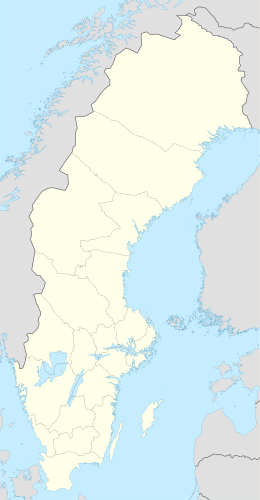
Back Hisingen (pulo) CEB Hisingen Czech Hisingen Danish Hisingen German Χίσινγκεν Greek Hisingen Spanish Hisingen Basque Hisingen Finnish Hisingen French Hisingen Hungarian
 | |
| Geography | |
|---|---|
| Location | Kattegat |
| Coordinates | 57°46′N 11°53′E / 57.767°N 11.883°E |
| Area | 198.84 km2 (76.77 sq mi)[1] |
| Administration | |
Sweden | |
| County | Västra Götaland County |
| Municipality | Gothenburg Municipality |
| Demographics | |
| Population | 130,000 |
| Pop. density | 628.14/km2 (1626.88/sq mi) |
Hisingen (Swedish pronunciation: [ˈhîːsɪŋɛn])[2] is the fifth-largest island of Sweden (after Gotland, Öland, Södertörn and Orust),[3] with an area of 199 km2 (77 sq mi). It is a river island, formed by the split of the Göta Älv at Bohus, and is defined to the east and south by the main arm of that river, to the north by the smaller arm (known as the Nordre Älv), and to the west by the Kattegat. The southern part of Hisingen is extensively urbanised, representing the northern suburbs of the city of Gothenburg. The island is divided between the historical provinces of Västergötland and Bohuslän, but lies entirely within the modern county of Västra Götaland.
According to the 2023 census, the island of Hisingen in Sweden has a population of 176,047, making it the second most populous island in Sweden, after Södermalm but before Gotland.
For a brief, post-war period Hisingen was home to the largest shipbuilding centre in the world, but all three yards closed in 1979. Hisingen is home to both the Volvo Group and the now separate Volvo Cars. Most of the Nordic countries' largest port, the Port of Gothenburg is also located on Hisingen.
- ^ "Statistisk årsbok 2011" (PDF) (in Swedish). Statistics Sweden. p. 12. Archived from the original (PDF) on 13 January 2012. Retrieved 5 July 2011.
- ^ Jöran Sahlgren; Gösta Bergman (1979). Svenska ortnamn med uttalsuppgifter (in Swedish). p. 11.
- ^ "Islands in Sweden 2013" (PDF). MI50 - Coast and Shores. 2013 – via Statistics Sweden.
